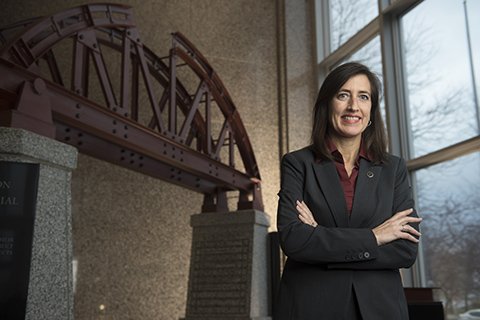Nancy Daubenberger: Building bridges

Written by Greg Breining
March 2, 2017
Since she was good at math and enjoyed building things, Nancy Daubenberger (CivE M.S. ’97) thought becoming an architect would be a good fit. Soon she discovered architecture had a big aesthetic component, and she enjoyed the nuts and bolts better. So she switched to civil engineering.
“That was a hurdle—changing my major and just trying to understand what engineering was about,” she said.
After graduation and working as a consultant for a couple years, she came to the Minnesota Department of Transportation’s (MnDOT) Bridge Office. She became an area engineer in the south Twin Cities Metro and then moved back to the Bridge Office as a planning engineer, just a few months before the deadly collapse of the I-35W bridge over the Mississippi River in Minneapolis. “It was a tragic and very challenging time for MnDOT,” she said. “But we’ve made changes in the way we do things because of what we learned from that.”
Daubenberger faced a common obstacle for women in the workplace—balancing work and family. After her second child was born and in daycare, both children would often come down sick with colds and ear infections.
“Suddenly I felt like, wow, my husband and I are both missing a lot of work to take care of our children. Maybe this whole gig with trying to be a mom and an engineer at the same time is not going to work,” Daubenberger said.
A supervisor gave her encouragement. “He said, ‘Don’t give up. My wife and I went through the same thing—working full-time, kids in day care, they get sick more often. Hang in there, you will get past this tough time,’” Daubenberger said. “He was absolutely right. I find myself giving that advice to young moms.”
Men still outnumber women in her field, especially in engineering and management, but that’s changing. “Over the years as I sit in meetings and look around the table, very rare is it that I’m the only woman in the room anymore,” Daubenberger said. “On the other hand, though, when I go to meet with our construction contractors, I find myself in the small minority as a woman sitting at the table with them.”
Yet it’s important to achieve greater parity. “In the science and engineering fields, we need to represent the communities in which we work and for which we provide our services and products,” she said. “We can only do a good job in advancing our field if we can bring diverse perspectives to the table.”
For women in college or just entering the job market, Daubenberger recommends finding peers for support and help in landing jobs. She suggests students connect with working scientists and engineers through student organizations of professional groups, such as the American Society of Civil Engineers.
Finally, she recommends young women build confidence through public speaking. “The more we get used to speaking in front of groups, the more comfortable we are,” she said. “It’s not about overcoming fears of public speaking then. Instead, you can focus your energy on the messages you’re trying to send.”
